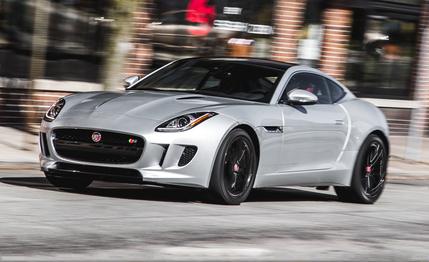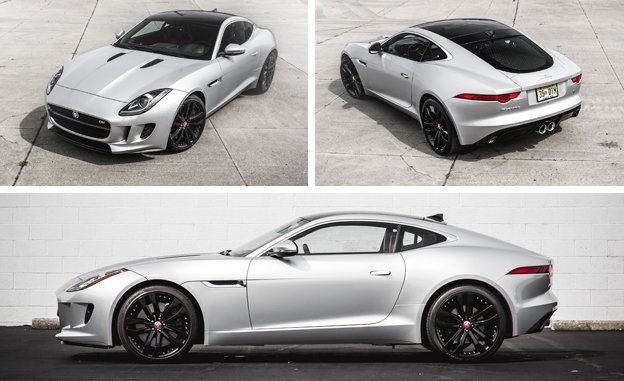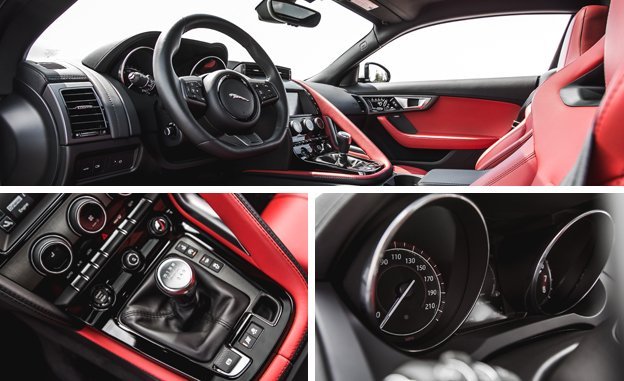
 Instrumented Test
Instrumented Test
To exit the parking lot behind our local barbecue hangout, you enter a narrow lane between two brick buildings before emerging beside the restaurant’s outdoor patio. So, we tapped the console button to open the flaps in the Jaguar F-type’s exhaust system and revved it a bit in first gear just to hear it echo in this alley. As we pulled up beside the patio, the al fresco diners had all eyes on us. The Jag’s sculpted body didn’t disappoint the curious, who stared, their forks full of smoked meat poised halfway to mouths that formed the words, “What’s that?”
Many want to drive cars like the F-type coupe just for such moments. Enticed by the design—which is very 21st-century and yet evocative of the 1960s E-type—and awed by the sounds it emits, they’d buy this car just for the attention. We’re hardly immune to the charms of style that sizzles and exhausts that crackle, but those attributes make us want to get away from other people and find a great road to get fully involved in driving.
The promise of fuller involvement arrived with the addition of a six-speed manual transmission for 2016. Available in coupe and convertible F-types with the supercharged V-6 (340 horsepower in the base version, 40 more in the S tested here), the ZF-built unit is similar to that found in some BMWs. While the F-type R, with its 550-hp V-8 and all-wheel drive, vies for supercar status, the S is content being a sports car that’s purpose-built to provide a sensory experience in motion. For many among us, that means a clutch pedal should at least be an option. Now it is.
We last tested an F-type S coupe a year ago when the only transmission was the ZF eight-speed automatic with paddle shifters. That familiar combo makes quick shifts and also includes a launch-control feature, so we didn’t expect the manual to beat it at the test track. Even less did we expect the clutch to give up on the first run. But that’s what happened. Our test car, Jaguar explained, was a preproduction model and its single-plate dry clutch was not to final spec. Worse, it had been subjected to the rigors of the press introduction. It’s evident at these events that some car reviewers lack very much experience with clutch pedals. And others are hoons who show no mercy in pursuit of great, smoking-tires videos. So, okay, it was abused and it failed. After a local dealer installed a production-spec clutch, we gave it some break-in miles before heading back to the track.


This is a nice shifter. Not Honda or Mazda flickable, but with fairly short throws and a precise motion, somewhere between BMW and Porsche. The light clutch action demands a sensitive foot to feel it engage. The electronics can match revs on upshifts but, curiously, not on downshifts; at least the pedals are nicely situated for heel-and-toe work, making a do-it-yourself throttle blip easy. Even if your execution is less perfect than robots can manage, it’s worth the effort for the sound effects. Mostly, the manual makes the entire driving experience more sensory and involving, even when all you’re doing is accelerating from a light in traffic.
We saw a zero-to-60-mph time of 4.9 seconds at the track, 0.6 slower than the 2015 automatic. The half-second gap was still there at the quarter-mile mark (13.4 versus 12.9) along with a speed differential of 4 mph (105 to 109 mph). Our driver noted that the new clutch often slipped just a bit before the tires broke loose at launch; he wasn’t alarmed but it may have affected the times.
This car wore Pirelli P Zero tires on optional 20-inch rims, whereas the 2015 automatic car had the same tire on the standard 19s. The 2016 edition circled our skidpad at 0.98 g compared with 0.90 g a year ago. That puts it on par with a Porsche Cayman S. The 70-to-zero-mph braking also improved, to 149 feet from 157, also more competitive with the Cayman’s 146.
While this Jaguar wins no drag races against Corvettes, Caymans, or Alfa Romeo 4Cs, it’s in their performance ballpark. Turn off all the electronic aids and it gets a bit more tail-happy than some, although without the brute power of the available V-8 (and its standard automatic), the throttle-induced drift is easily managed with a quick flick of steering.
Another new element since our last test is that electrically boosted power-steering assist has supplanted the previous hydraulic unit. This is not the disaster it was in the early days of electric assist. The new unit provides good on-center feel and feedback. We’d prefer a little less assistance—the wheel feels light, but given that other controls are, too, it’s commensurate and balanced. Few things are as unsettling in an otherwise good car as a mismatch of efforts among the pedals, shifter, and steering. The handling shows only mild understeer easily balanced out with power. It’s every bit as delightful on sinuous roads as ever.


If the clutch and steering are light, the F-type itself isn’t. The aluminum-bodied F-type weighs nearly 3800 pounds, even though it’s shorter and narrower than the 3600-pound Corvette Z06. Still, this 2016 car weighed 43 pounds less than did the earlier automatic (Jaguar says the manual trans saves 22 pounds). Its window sticker was also lighter, by about $2700. The manual model starts at $1500 less than the automatic S coupe. Jag also has reconfigured the packaging for 2016, so standard equipment for today’s S includes a panoramic glass roof, configurable dynamic controls, and 14-way power seats, all of which used to cost extra. (The F-type also benefits from an extension of the free maintenance, warranty, and roadside assistance to 5 years/60,000 miles.)
The deep options list still can be a shock, and this test car had $11,600 worth of extras. That included $600 for the rhodium silver paint (only non-metallic white, red, and black are free), $1500 for performance seats (a worthy addition), $2500 for 20-inch wheels in black, $3900 for the Premium + Vision package (blind-spot monitor, parking sensors, rear camera, a power tailgate, heated seats and steering wheel, “adaptive and intelligent” lights, dual-zone automatic climate control, etc.), and $3100 for the Extended Leather pack.
No longer seen on sporty Jaguars’ features lists are the Old World Brit-car standards of burled walnut, Wilton wool carpet, and Connolly-brand leather. Jaguar chief designer Ian Callum is not a fan of the Victorian-era gentlemen’s-club ambience, instead outfitting his creations with more modern materials—authentic as ever, but freshly reconsidered. For 2016, the cabin steps further into the future with a new telematics system dubbed InControl, and the instrument cluster has been updated with more advanced digital displays.
We welcome this “the past is past” ethos generally, as long as Jaguar remains among the shrinking number of manufacturers who offer real sports cars with three pedals.